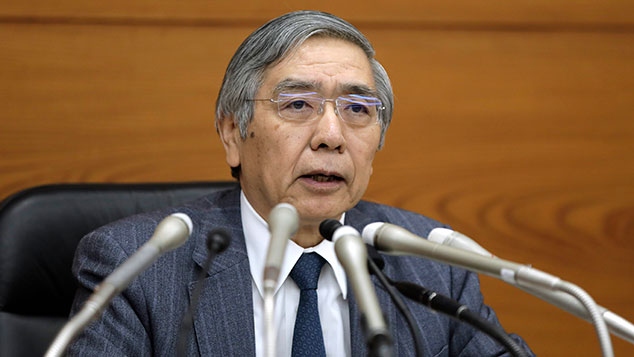
This morning, the governor of the Bank of Japan – Haruhiko Kuroda – gave an uneventful speech after an uneventful central bank meeting.
In short, it’ll be business as usual. The Bank has no intention of changing monetary policy (so ten-year Japanese government bonds are staying at 0%, whatever it takes).
So Japan will continue to merrily finance its government’s spending. The yen will stay weak. If it’s possible to generate inflation in our modern “new normal” era, the central bank and government of Japan will find a way.
No wonder everyone’s getting so bullish…
Can the Japanese market break through this important price level?
Everyone’s getting increasingly excited about Japan. People always get excited about markets that go up. But some of this is also about very long-term technical analysis, or charting – the art of looking for repeating patterns in price charts, as a method of planning entry and exit points from an investment.
You might be tempted to dismiss technical analysis as modern-day haruspicy (and it’s true that some charts do look like someone chucked a load of goat entrails on the page). But you shouldn’t.
At an intuitive level, charting makes sense. The only thing about markets that doesn’t change is human nature. You can easily argue that persistent psychological tics such as “anchoring” (our tendency to attach significance to a specific number for no fundamental reason other than that it’s where we bought in, or a recent high or low) should be reflected in the way that prices behave.
At a more “meta” level, there’s also the fact that we are pattern-spotting creatures. Human beings seek order in everything, including events that we intellectually understand to be entirely random. So if enough people are looking for patterns, and they perceive those patterns in similar ways, that will influence their actions, and in turn, is likely to lead to the patterns persisting for longer than they otherwise would.
So, for example, if enough traders expect a falling share price to bounce off a strong “support” level, then they will act accordingly. As a result, the share price will indeed bounce.
None of that means it’s easy or foolproof. But the point is, even if you don’t pay attention to the charts, lots of other people do. So at the very least, you should avoid dismissing it out of hand.
Right now, the Japanese market (as measured by the Topix index) is banging on what Jonathan Allum of SMBC Nikko describes – rather appropriately, given the date – as “the iron coffin lid”. Basically, this is a thick line of “resistance” that goes back as far as the 1990s.
The Topix index first rose above the 1,800 mark in 1987. It fell back below that level in late 1990. It clawed it back for most of 1991, lost it again, and then pretty much has never regained it since.
It has frequently made a crack at the 1,800 mark over the past 25 years. But it has yet to burst through decisively. The idea is that if it does, it’ll represent a huge “breakout”.
Right now, the Topix is trading at around the 1,760 mark. We haven’t been here since 2007, which was the last serious attempt at 1,800.
The idea is that if it manages to “break out” from here, then the sky is – not quite the limit – but it could be on the way to its 1989 high, above 2,800.
Of course, it’s not just about the technical picture – although in terms of timing, that’s certainly bound to have caught a lot of investors’ eyes. As Eoin Treacy points out on FullerTreacyMoney, Japan is also “one of the few countries in the world running simultaneously easy monetary and fiscal policy”. Given the country’s huge debt pile, “it needs to generate inflation if it is to ever have any hope” of paying it back.
On top of that, stocks are still relatively cheap, particularly compared to the S&P 500 in the US.
David Rosenberg of Gluskin Sheff (who is by no means an unthinking bull – if anything, he tends to the bearish side) summed up the case quite forcefully in his most recent daily research report: “I maintain that Japanese stocks have not been this attractive in my entire professional life, which spans 30 years. Valuations. Liquidity. Structural reforms. Under-owned both globally and locally.”
That’s quite the recommendation.
Why we should be wary if Japan stalls here
The one thing that gives me pause on Japan is not specific to Japan, but to wider markets and how they tend to work in general.
You see, Japan is a bit of a classic “what do I buy once everything else in the world has gone up?” play. (That’s also known as “late-cycle” in the City jargon).
As Jamie McGeever of Reuters pointed out on Twitter this morning, global stocks (as measured by the MSCI index) have risen on a monthly basis for 12 months in a row now – the longest winning streak on record. That seems very punchy.
So when Japan is doing well (particularly relative to the US – it’s actually done pretty well relative to the rest of the world for several years now), I do wonder – as is my bearish wont – if it simply means that we’re close to the turning point.
For example, the last time the Topix had a good charge at the old iron coffin lid, was in 2007. Indeed, the Topix briefly poked its head up to 1,814 on 23 February 2007. And we all know what happened next.
Then again, that’s not a reason to avoid Japan, so much as a reason to be alert for trouble in global markets generally. We’ll be keeping a close eye on that 1,800 level over the next few months.